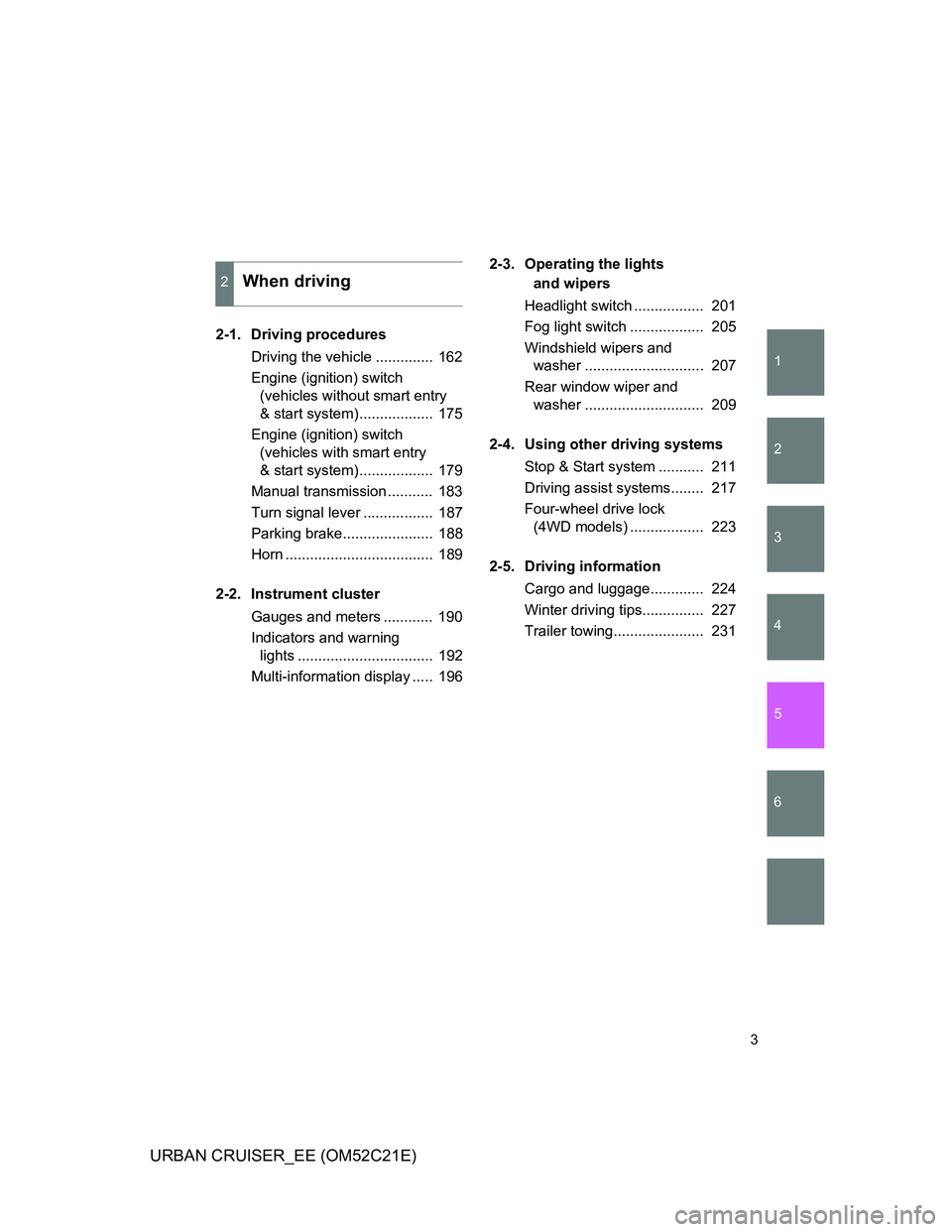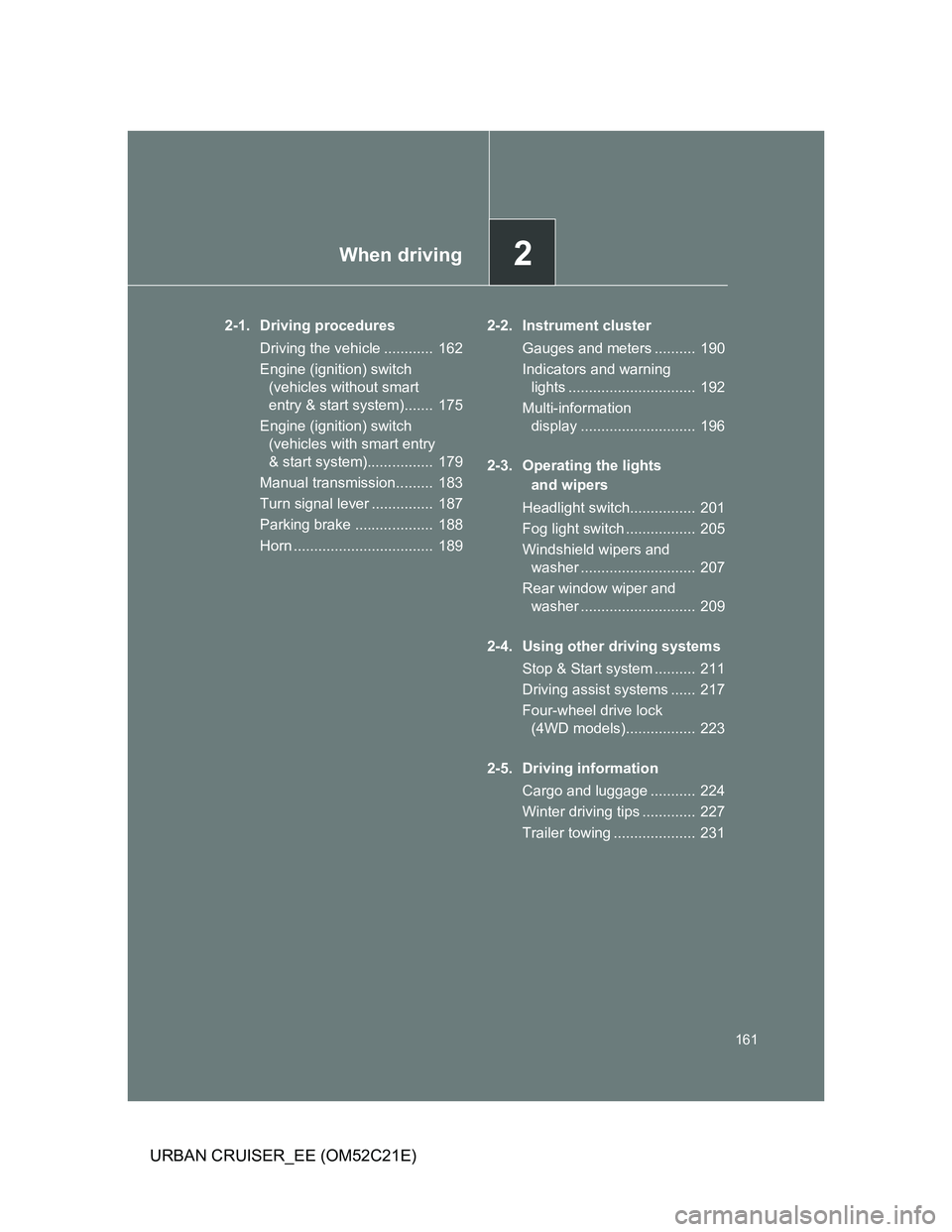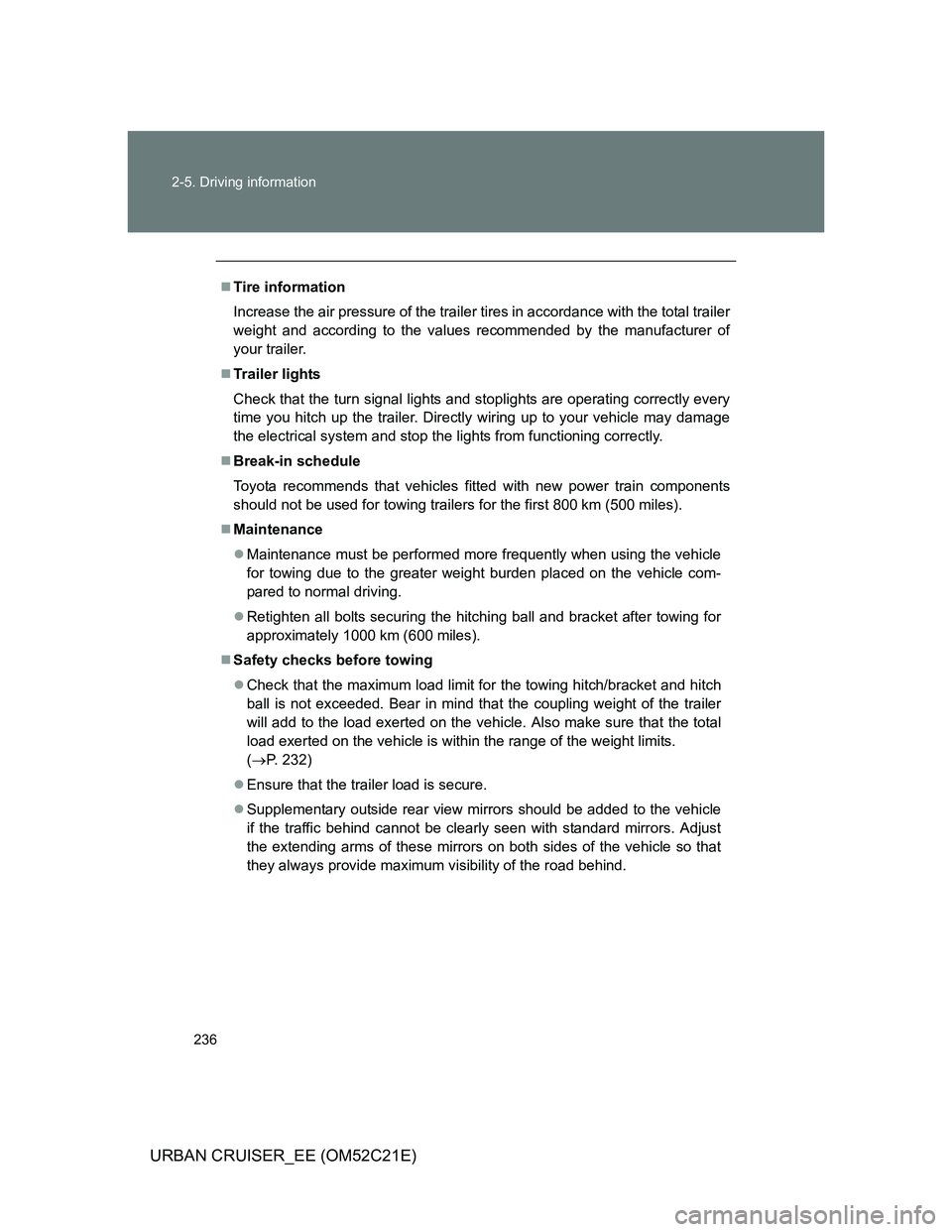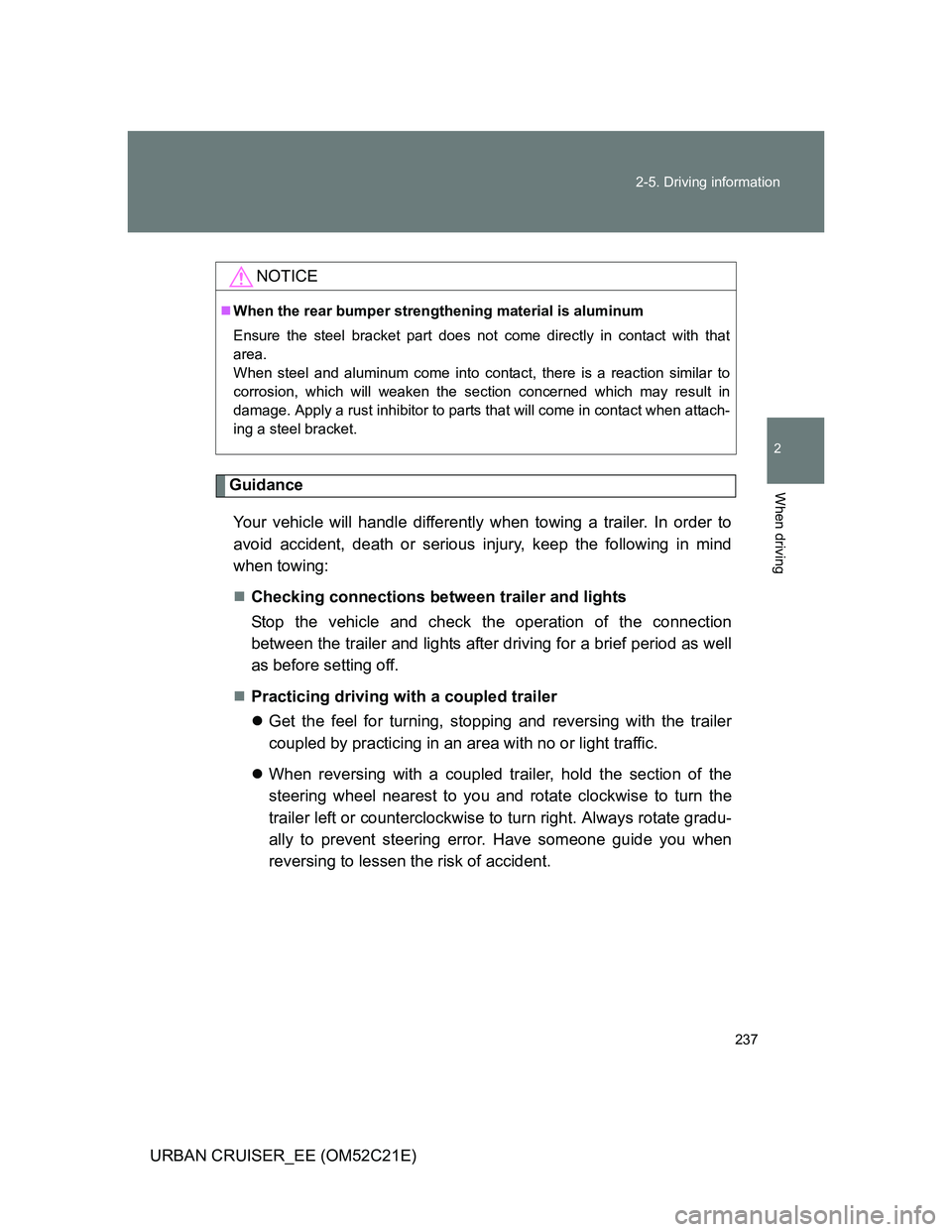Page 3 of 532

1
2
3
4
5
6
3
URBAN CRUISER_EE (OM52C21E)
2-1. Driving procedures
Driving the vehicle .............. 162
Engine (ignition) switch
(vehicles without smart entry
& start system).................. 175
Engine (ignition) switch
(vehicles with smart entry
& start system).................. 179
Manual transmission ........... 183
Turn signal lever ................. 187
Parking brake...................... 188
Horn .................................... 189
2-2. Instrument cluster
Gauges and meters ............ 190
Indicators and warning
lights ................................. 192
Multi-information display ..... 1962-3. Operating the lights
and wipers
Headlight switch ................. 201
Fog light switch .................. 205
Windshield wipers and
washer ............................. 207
Rear window wiper and
washer ............................. 209
2-4. Using other driving systems
Stop & Start system ........... 211
Driving assist systems........ 217
Four-wheel drive lock
(4WD models) .................. 223
2-5. Driving information
Cargo and luggage............. 224
Winter driving tips............... 227
Trailer towing...................... 231
2When driving
Page 161 of 532

2When driving
161
URBAN CRUISER_EE (OM52C21E)
2-1. Driving procedures
Driving the vehicle ............ 162
Engine (ignition) switch
(vehicles without smart
entry & start system)....... 175
Engine (ignition) switch
(vehicles with smart entry
& start system)................ 179
Manual transmission......... 183
Turn signal lever ............... 187
Parking brake ................... 188
Horn .................................. 1892-2. Instrument cluster
Gauges and meters .......... 190
Indicators and warning
lights ............................... 192
Multi-information
display ............................ 196
2-3. Operating the lights
and wipers
Headlight switch................ 201
Fog light switch ................. 205
Windshield wipers and
washer ............................ 207
Rear window wiper and
washer ............................ 209
2-4. Using other driving systems
Stop & Start system .......... 211
Driving assist systems ...... 217
Four-wheel drive lock
(4WD models)................. 223
2-5. Driving information
Cargo and luggage ........... 224
Winter driving tips ............. 227
Trailer towing .................... 231
Page 164 of 532
164 2-1. Driving procedures
URBAN CRUISER_EE (OM52C21E)
Driving in the rain
Drive carefully when it is raining, because visibility will be reduced, the
windows may become fogged-up, and the road will be slippery.
Drive carefully when it starts to rain, because the road surface will be
especially slippery.
Refrain from high speeds when driving on an expressway in the rain,
because there may be a layer of water between the tires and the road
surface, preventing the steering and brakes from operating properly.
Breaking in your new Toyota
To extend the life of the vehicle, the following precautions are recommended
to observe:
For the first 300 km (200 miles):
Avoid sudden stops.
For the first 800 km (500 miles):
Do not tow a trailer.
For the first 1000 km (600 miles):
• Do not drive at extremely high speeds.
• Avoid sudden acceleration.
• Do not drive continuously in the low gears.
• Do not drive at a constant speed for extended periods.
Page 231 of 532

231
2-5. Driving information
2
When driving
URBAN CRUISER_EE (OM52C21E)
Trailer towing
Your vehicle is designed primarily as a passenger carrying vehicle.
Towing a trailer will have an adverse effect on handling, perfor-
mance, braking, durability, and fuel consumption. Your safety and
satisfaction depend on the proper use of correct equipment and cau-
tious driving habits. For your safety and the safety of others, do not
overload the vehicle or trailer.
To tow a trailer safely, use extreme care and drive the vehicle in
accordance with the trailer’s characteristics and operating condi-
tions.
Toyota warranties do not apply to damage or malfunction caused by
towing a trailer for commercial purposes.
Ask your local authorized Toyota dealer or repairer, or another duly
qualified and equipped professional, for further details before tow-
ing, as there are additional legal requirements in some countries.
Weight limits
Check the allowable towing capacity, GVM (Gross Vehicle
Mass), MPAC (Maximum Permissible Axle Capacity), and per-
missible drawbar load before towing. (P. 494)
Towing hitch/bracket
Toyota recommends the use of the Toyota hitch/bracket for your
vehicle. Other products of a suitable nature and comparable
quality may also be used.
Page 232 of 532
232 2-5. Driving information
URBAN CRUISER_EE (OM52C21E)
Important points regarding trailer loads
Total trailer weight and permissible drawbar load
Total trailer weight
Weight of the trailer itself plus the
trailer load should be within the
maximum towing capacity.
Exceeding this weight is danger-
ous.
(P. 494)
When towing a trailer, use a fric-
tion coupler or friction stabilizer
(sway control device).
Permissible drawbar load
Allocate the trailer load so that
the drawbar load is greater than
25 kg (55.1 lb.) or 4% of the tow-
ing capacity. Do not let the draw-
bar load exceed the indicated
weight. (P. 494)
Page 233 of 532

233 2-5. Driving information
2
When driving
URBAN CRUISER_EE (OM52C21E)Information tag (manufacturer’s label)
Gross vehicle mass
The combined weight of the
driver, passengers, luggage, tow-
ing hitch, total curb mass and
drawbar load should not exceed
the gross vehicle mass by more
than 100 kg (220.5 lb.). Exceed-
ing this weight is dangerous.
Maximum permissible rear
axle capacity
The weight borne by the rear axle
should not exceed the maximum
permissible axle capacity by 15%
or more. Exceeding this weight is
dangerous.
The values for towing capacity
were derived from testing con-
ducted at sea level. Take note
that engine output and towing
capacity will be reduced at high
altitudes.
CAUTION
When the gross vehicle mass limit or maximum permissible axle
capacity is exceeded
Do not exceed the established speed limit for towing a trailer in built-up
areas or 100 km/h (62 mph), whichever is lower.
Failing to observe this precaution may lead to an accident causing death or
serious injury.
Page 236 of 532

236 2-5. Driving information
URBAN CRUISER_EE (OM52C21E)
Tire information
Increase the air pressure of the trailer tires in accordance with the total trailer
weight and according to the values recommended by the manufacturer of
your trailer.
Trailer lights
Check that the turn signal lights and stoplights are operating correctly every
time you hitch up the trailer. Directly wiring up to your vehicle may damage
the electrical system and stop the lights from functioning correctly.
Break-in schedule
Toyota recommends that vehicles fitted with new power train components
should not be used for towing trailers for the first 800 km (500 miles).
Maintenance
Maintenance must be performed more frequently when using the vehicle
for towing due to the greater weight burden placed on the vehicle com-
pared to normal driving.
Retighten all bolts securing the hitching ball and bracket after towing for
approximately 1000 km (600 miles).
Safety checks before towing
Check that the maximum load limit for the towing hitch/bracket and hitch
ball is not exceeded. Bear in mind that the coupling weight of the trailer
will add to the load exerted on the vehicle. Also make sure that the total
load exerted on the vehicle is within the range of the weight limits.
(P. 232)
Ensure that the trailer load is secure.
Supplementary outside rear view mirrors should be added to the vehicle
if the traffic behind cannot be clearly seen with standard mirrors. Adjust
the extending arms of these mirrors on both sides of the vehicle so that
they always provide maximum visibility of the road behind.
Page 237 of 532

237 2-5. Driving information
2
When driving
URBAN CRUISER_EE (OM52C21E)
Guidance
Your vehicle will handle differently when towing a trailer. In order to
avoid accident, death or serious injury, keep the following in mind
when towing:
Checking connections between trailer and lights
Stop the vehicle and check the operation of the connection
between the trailer and lights after driving for a brief period as well
as before setting off.
Practicing driving with a coupled trailer
Get the feel for turning, stopping and reversing with the trailer
coupled by practicing in an area with no or light traffic.
When reversing with a coupled trailer, hold the section of the
steering wheel nearest to you and rotate clockwise to turn the
trailer left or counterclockwise to turn right. Always rotate gradu-
ally to prevent steering error. Have someone guide you when
reversing to lessen the risk of accident.
NOTICE
When the rear bumper strengthening material is aluminum
Ensure the steel bracket part does not come directly in contact with that
area.
When steel and aluminum come into contact, there is a reaction similar to
corrosion, which will weaken the section concerned which may result in
damage. Apply a rust inhibitor to parts that will come in contact when attach-
ing a steel bracket.